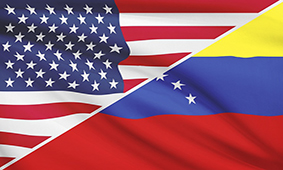
US refiners move on from Venezuelan heavy crude

The US imposed sanctions on Venezuela's oil industry on 25 January 2019 in a bid to support opposition leader Juan Guaido. Shipments wound down into May before falling to zero for the first time in more than 25 years.
US refiners replaced few of those barrels. Total US imports of heavy crude of 20°API or less — the bulk of Venezuelan supply — fell in the first ten months of 2019 to their lowest level since 2003, according to Energy Information Administration data.
Venezuelan alternatives last year lacked the quality discounts that refiners expect to fill heavy crude processing equipment. An outdated pricing formula helped to keep former US Gulf coast heavy benchmark Maya's discount to Ice Brent 20pc smaller than average in 2019.
And the broad lack of US Gulf coast access to Western Canadian Select (WCS) heavy sour barrels helped to tilt that crude toward record discounts to West Texas Intermediate crude in late 2018. A provincial curtailment program reigning in Alberta production left discounts too low to support costly rail transportation.
Though shipments of Canadian crude heavier than 24°API to the Gulf coast increased by 3pc, to 490,000 b/d, the rise was far smaller than the 26pc increase from 2017 to 2018. The increase represented just 3pc of the roughly 500,000 b/d of Venezuelan crude that the region had averaged for imports in the 12 months preceding sanctions.
Refiners did look outside North America for supply. Chevron, which may continue its Venezuelan upstream joint venture but cannot import the crude to its 330,000 b/d refinery in Pascagoula, Mississippi, received an average 72,000 b/d of Venezuelan heavy crude in 2018. Imports from Iraq, Trinidad and Tobago and the UK picked up following the end of Venezuelan access last year. But overall heavy crude imports remained 6pc lower through the first ten months of 2019 than the same period of 2018.
Refiners adjust slates
Venezuela's US refining subsidiary Citgo cut deeper. The company added Brazilian and Trinidad and Tobago crude to its slate. Losing access to Venezuelan heavy crude still meant an average 43pc drop in heavy crude imports to its US Gulf coast refineries in 2019.
Others adjusted overall crude diets. Valero adopted its lightest crude slate in at least nine years in the third quarter of 2019, with sweet crudes making up 61pc of its total slate. The US independent refiner operates extensive complex refining capacity—sweet crudes made up less than half of its crude slate two years earlier.
PBF reported a middling 37pc share for heavy crude at its 190,000 b/d refinery in Chalmette, Louisiana, another former Venezuela joint venture. Citgo completed modifications that allowed its 157,500 b/d refinery in Corpus Christi, Texas, to increase its ability to process US light, sweet crude.
More sour shifts in 2020
A shifting sour crude market will shake out new alternatives this year. Mexico last fall adjusted its Maya formula to bring its crude more in line with the US Gulf coast heavy sour market. Alberta began easing — slowly — its curtailments and has worked to increase railed shipments to US buyers. And US refiners have expected new, tougher marine fuel specifications to open up new discounts for sour and heavy feedstocks this year.
Companies have already pounced on Russian or Baltic straight run fuel oil called M-100, which fell to steep discounts in October. Adopting the feedstock can reduce production of valuable clean fuels, but will still fill cokers at the right price.
M-100 shipped to the Atlantic coast averaged a $9.34/bl to Ice Brent in November — three times the Maya discount for the period. The feedstock plus transportation hit a more than $25/bl discount nadir in December before climbing back to a $15/bl discount.
By Elliott Blackburn


Trump weighs using $2 billion in CHIPS Act funding for critical minerals

Codelco cuts 2025 copper forecast after El Teniente mine collapse

Electra converts debt, launches $30M raise to jumpstart stalled cobalt refinery

Barrick’s Reko Diq in line for $410M ADB backing

Abcourt readies Sleeping Giant mill to pour first gold since 2014

Nevada army depot to serve as base for first US strategic minerals stockpile

SQM boosts lithium supply plans as prices flick higher

Viridis unveils 200Mt initial reserve for Brazil rare earth project

Tailings could meet much of US critical mineral demand – study

Kyrgyzstan kicks off underground gold mining at Kumtor

Kyrgyzstan kicks off underground gold mining at Kumtor

KoBold Metals granted lithium exploration rights in Congo

Freeport Indonesia to wrap up Gresik plant repairs by early September

Energy Fuels soars on Vulcan Elements partnership

Northern Dynasty sticks to proposal in battle to lift Pebble mine veto

Giustra-backed mining firm teams up with informal miners in Colombia

Critical Metals signs agreement to supply rare earth to US government-funded facility

China extends rare earth controls to imported material

Galan Lithium proceeds with $13M financing for Argentina project

Kyrgyzstan kicks off underground gold mining at Kumtor

Freeport Indonesia to wrap up Gresik plant repairs by early September

Energy Fuels soars on Vulcan Elements partnership

Northern Dynasty sticks to proposal in battle to lift Pebble mine veto

Giustra-backed mining firm teams up with informal miners in Colombia

Critical Metals signs agreement to supply rare earth to US government-funded facility

China extends rare earth controls to imported material

Galan Lithium proceeds with $13M financing for Argentina project

Silver price touches $39 as market weighs rate cut outlook

















